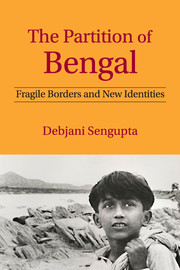Book contents
- Frontmatter
- Dedication
- Contents
- Acknowledgements
- Introduction
- 1 The Calcutta Riots in Representations and Testimonies
- 2 Noakhali and After: History, Memory and Representations
- 3 Colony Fiction: Displacement and Belonging in Post-Partition Bangla Fiction
- 4 From Dandakaranya to Marichjhapi: Refugee Rehabilitation in Bangla Partition Fictions
- 5 The Partition's Afterlife: Nation and Narration from the Northeast of India and Bangladesh
- 6 Uncanny Landscapes and Unstable Borders: Politics and Identity in Geo-Narratives of the Partition (2005–10)
- Bibliography
- Index
3 - Colony Fiction: Displacement and Belonging in Post-Partition Bangla Fiction
Published online by Cambridge University Press: 18 December 2015
- Frontmatter
- Dedication
- Contents
- Acknowledgements
- Introduction
- 1 The Calcutta Riots in Representations and Testimonies
- 2 Noakhali and After: History, Memory and Representations
- 3 Colony Fiction: Displacement and Belonging in Post-Partition Bangla Fiction
- 4 From Dandakaranya to Marichjhapi: Refugee Rehabilitation in Bangla Partition Fictions
- 5 The Partition's Afterlife: Nation and Narration from the Northeast of India and Bangladesh
- 6 Uncanny Landscapes and Unstable Borders: Politics and Identity in Geo-Narratives of the Partition (2005–10)
- Bibliography
- Index
Summary
Tahader Katha: Refugee city, city's refugees
In Calcutta, the arrival of the East Bengali Hindu refugee, culturally and psychologically, was a one-way journey, for they came to the city never to go back. Even before the vivisection of the country, the last years of colonial rule were marked by a worsening communal situation in Bengal that meant both Hindus and Muslims often left their homes in search of safer places to live. In the early months of 1947, when the partition was fast becoming a reality, people's places of sojourn and status changed dramatically as they left to congregate in areas that harboured co-religionists or decided to cross the borders. The ways in which they moved did not have a set pattern but depended on many factors like immoveable/moveable assets and particular skills or employability. However, one can safely assume that Hindu and Muslim movements across the borders had a similar trajectory, in that the exodus was over ‘a period of many years, sometimes in trickles and sometimes in big waves.’ The Muslim inhabitants in and around Calcutta fearing intimidation after the Calcutta Riots either left for East Pakistan or began to crowd at the border and the census of 1951 discovered 130,000 fewer Muslims in the city than expected. The void left by this large number especially in Calcutta and Nadia, that saw an exodus of almost one-third of its Muslim population, was filled by the wave of Hindu refugees entering West Bengal especially after 1950. India and Pakistan had signed the Evacuee Properties Act that allowed a migrant Muslim family to reoccupy their home if they came back by 31 March 1951 but in many instances these deserted properties were grabbed by Hindus who had entered the state from East Bengal or their local allies. There was no systematic attempt to record the actual number of fleeing Muslims and even the government assessment of Hindus entering the state was sometimes way off the mark. According to a government estimate, in 1961, the Hindu refugee migrants to the city comprised 18 per cent of the total population of the city of 29.27 lakh and the conservative estimate is that ‘on the whole, the net inflow of refugees to West Bengal is estimated at about 6 million up to 1973.’
- Type
- Chapter
- Information
- The Partition of BengalFragile Borders and New Identities, pp. 117 - 156Publisher: Cambridge University PressPrint publication year: 2015



